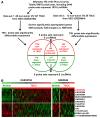Upregulated long non-coding RNA LINC00152 expression is associated with progression and poor prognosis of tongue squamous cell carcinoma
- PMID: 28367232
- PMCID: PMC5370496
- DOI: 10.7150/jca.17510
Upregulated long non-coding RNA LINC00152 expression is associated with progression and poor prognosis of tongue squamous cell carcinoma
Abstract
Altered expression of long non-coding RNAs (lncRNAs) associated with human carcinogenesis and might be used as diagnosis and prognosis biomarkers. However, the expression of lncRNAs in tongue squamous cell carcinoma (TSCC) and their relevance on the diagnosis, progression and prognosis of TSCC have not been thoroughly elucidated. To discover novel TSCC-related lncRNAs, we analyzed the lncRNA expression patterns in two sets of previously published TSCC gene expression profile data (GSE30784 and GSE9844), and found that long intergenic non-coding RNA 152 (LINC00152) was significantly upregulated in TSCC samples. We then detected LINC00152 expression in two other cohorts of TSCC samples. Quantitative Real time PCR (qRT-PCR) results indicated that LINC00152 was highly expressed in 15 primary TSCC biopsies when compared with 14 adjacent non-tumor tongue squamous cell epithelium samples. The expression of LINC00152 was also measured in 182 paraffin-embedded human TSCC tissues by in situ hybridization, increased expression of LINC00152 was significantly correlated with TSCC progression, such as T stage (p = 0.009), N stage (p = 0.036), TNM stage (p = 0.017), and associated with relapse (p < 0.001), and invasion (p < 0.001). Kaplan-Meier analysis demonstrated that increased LINC00152 expression contributed to both poor overall survival (p = 0.006) and disease-free survival (p = 0.007) of TSCC patients. These findings suggest that LINC00152 might serve as a potential biomarker for early detection and prognosis prediction of TSCC.
Keywords: Long non-coding RNA (LncRNA); long intergenic non-coding RNA 152 (LINC00152); metastasis; prognosis.; tongue squamous cell carcinoma (TSCC).
Conflict of interest statement
Competing Interests: The authors have declared that no competing interest exists.
Figures




Similar articles
-
Overexpression long non-coding RNA LINC00673 is associated with poor prognosis and promotes invasion and metastasis in tongue squamous cell carcinoma.Oncotarget. 2017 Mar 7;8(10):16621-16632. doi: 10.18632/oncotarget.14200. Oncotarget. 2017. PMID: 28039470 Free PMC article.
-
Long non-coding RNA LINC00152 acts as a sponge of miRNA-193b-3p to promote tongue squamous cell carcinoma progression.Oncol Lett. 2020 Mar;19(3):2035-2042. doi: 10.3892/ol.2020.11293. Epub 2020 Jan 13. Oncol Lett. 2020. PMID: 32194700 Free PMC article.
-
Long non-coding RNA HOTTIP is correlated with progression and prognosis in tongue squamous cell carcinoma.Tumour Biol. 2015 Nov;36(11):8805-9. doi: 10.1007/s13277-015-3645-2. Epub 2015 Jun 10. Tumour Biol. 2015. PMID: 26058875
-
Improved characterization of the relationship between long intergenic non-coding RNA Linc00152 and the occurrence and development of malignancies.Cancer Med. 2019 Aug;8(10):4722-4731. doi: 10.1002/cam4.2245. Epub 2019 Jul 4. Cancer Med. 2019. PMID: 31270960 Free PMC article. Review.
-
MicroRNAs in human tongue squamous cell carcinoma: From pathogenesis to therapeutic implications.Oral Oncol. 2017 Apr;67:124-130. doi: 10.1016/j.oraloncology.2017.02.015. Epub 2017 Feb 27. Oral Oncol. 2017. PMID: 28351566 Review.
Cited by
-
Long non-coding RNA LINC00152 in cancer: Roles, mechanisms, and chemotherapy and radiotherapy resistance.Front Oncol. 2022 Aug 10;12:960193. doi: 10.3389/fonc.2022.960193. eCollection 2022. Front Oncol. 2022. PMID: 36033524 Free PMC article. Review.
-
GRASLND regulates melanoma cell progression by targeting the miR-218-5p/STAM2 axis.J Transl Med. 2024 Jul 26;22(1):684. doi: 10.1186/s12967-024-05397-z. J Transl Med. 2024. PMID: 39060946 Free PMC article.
-
Blocking LINC00152 suppresses glioblastoma malignancy by impairing mesenchymal phenotype through the miR-612/AKT2/NF-κB pathway.J Neurooncol. 2018 Nov;140(2):225-236. doi: 10.1007/s11060-018-2951-0. Epub 2018 Jul 24. J Neurooncol. 2018. PMID: 30043319
-
Construction of a lncRNA-mRNA Co-Expression Network for Nasopharyngeal Carcinoma.Front Oncol. 2022 Jul 7;12:809760. doi: 10.3389/fonc.2022.809760. eCollection 2022. Front Oncol. 2022. PMID: 35875165 Free PMC article.
-
Non-Coding RNAs in Oral Cancer: Emerging Roles and Clinical Applications.Cancers (Basel). 2023 Jul 25;15(15):3752. doi: 10.3390/cancers15153752. Cancers (Basel). 2023. PMID: 37568568 Free PMC article. Review.
References
-
- Kimple AJ, Welch CM, Zevallos JP. et al. Oral cavity squamous cell carcinoma-an overview. Oral Health Dent Manag. 2014;13:877–82. - PubMed
-
- Schwam ZG, Judson BL. Improved prognosis for patients with oral cavity squamous cell carcinoma: Analysis of the National Cancer Database 1998-2006. Oral Oncol. 2016;52:45–51. - PubMed
-
- Bagan J, Sarrion G, Jimenez Y. Oral cancer: clinical features. Oral Oncol. 2010;46:414–7. - PubMed
-
- Sciubba JJ. Oral cancer. The importance of early diagnosis and treatment. Am J Clin Dermatol. 2001;2:239–51. - PubMed
LinkOut - more resources
Full Text Sources
Other Literature Sources

